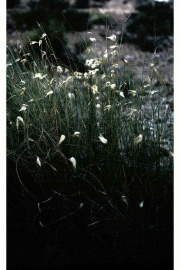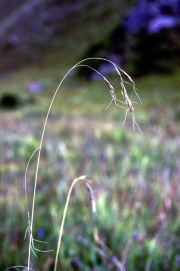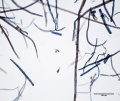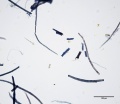Difference between revisions of "Esparto grass"
(username removed) |
|||
| (13 intermediate revisions by 3 users not shown) | |||
| Line 1: | Line 1: | ||
| − | [[File:lygeumpd1.jpg|thumb|Esparto grass | + | [[File:lygeumpd1.jpg|thumb|Esparto grass ''Lygeum spartum'']] |
| − | |||
| − | ''Lygeum spartum'']] | ||
== Description == | == Description == | ||
| − | A tough, coarse, spiky grass (''Stipa tenacissima'' or ''Lygeum spartum)'' native to southern Spain | + | A tough, coarse, spiky grass (''Stipa tenacissima'' or ''Lygeum spartum)'' native to southern Spain anst grades are thought to come from Spain (Spanish grass) while less expensive grades come from northern Africa ([[tripoli]]). The slender, wiry grass was used for basketry, ropes, and mats since ancid northern Africa. The beent times. The gray-green spear-like leaves of this desert plant produce fine, light fibers that are about one centimeter long. The fibers have a high proportion of [[alpha cellulose]]. They produce a high-quality, lightweight paper that is used for writing papers as well as for intaglio color printing. Esparto fibers are used extensively in England and Scotland for the production of paper, but rarely used in the U.S. because [[wood pulp]] is plentiful. The presence of esparto in a paper may be determined by the [[Hertzberg stain|Hertzberg test]] (iodine-chloride solution - positive stains deep violet) or by boiling the specimen in 1% solution of [[aniline]] (positive turns pink) (Roberts and Etherington 1982). |
| − | [[File:stipapd1.jpg|thumb|Esparto grass | + | [[File:stipapd1.jpg|thumb|Esparto grass ''Stipa spp.'']] |
| − | |||
== Synonyms and Related Terms == | == Synonyms and Related Terms == | ||
''Stipa tenacissima; Lygeum spartum''; alfa grass; alpha grass; halfa grass; Spanish grass; esparto fibers; sparto; tripoli; esparto (Esp.); esparto (gras) (''Stipa tenacissima'')=spartelgras (Ned); | ''Stipa tenacissima; Lygeum spartum''; alfa grass; alpha grass; halfa grass; Spanish grass; esparto fibers; sparto; tripoli; esparto (Esp.); esparto (gras) (''Stipa tenacissima'')=spartelgras (Ned); | ||
| − | == | + | ==Physical and Chemical Properties== |
Fibers are about 1 cm in length. | Fibers are about 1 cm in length. | ||
| − | + | Paper fiber type: grass. Using transmitted light microscopy, fibers appear thick-walled, short and cylindrical with pointed ends. Associated cells for identification: comma-shaped cells are unique to Esparto, and serrated epidermal cells (tricomb cells) are present in all grasses. Appearance with [[Graff "C" stain]]: dark blue. Average dimensions of fibers: length 1.2mm; width 13μm. Common pulping method: [[Soda]]. | |
| − | |||
| − | |||
== Additional Images == | == Additional Images == | ||
| − | |||
<gallery> | <gallery> | ||
File:esparto_proc_det.jpg|Esparto | File:esparto_proc_det.jpg|Esparto | ||
| + | File:Esparto 40x se commas.jpg|Esparto stained with Graff "C" stain | ||
| + | File:Esparto 40x serratedepi.jpg|Esparto tricomb cells | ||
</gallery> | </gallery> | ||
| + | ==Resources and Citations== | ||
| − | + | * ''Encyclopedia Britannica'', http://www.britannica.com Comment: esparto" [Accessed October 17, 2001]. | |
| − | * '' | + | * Marja-Sisko Ilvessalo-Pfäffli. ''Fiber Atlas: Identification of Papermaking Fibers (Springer Series in Wood Science).'' Springer, 1995. |
* Richard S. Lewis, ''Hawley's Condensed Chemical Dictionary'', Van Nostrand Reinhold, New York, 10th ed., 1993 | * Richard S. Lewis, ''Hawley's Condensed Chemical Dictionary'', Van Nostrand Reinhold, New York, 10th ed., 1993 | ||
| Line 43: | Line 40: | ||
* Ralph Mayer, ''A Dictionary of Art Terms and Techniques'', Harper and Row Publishers, New York, 1969 (also 1945 printing) | * Ralph Mayer, ''A Dictionary of Art Terms and Techniques'', Harper and Row Publishers, New York, 1969 (also 1945 printing) | ||
| + | |||
| + | * Walter Rantanen. 'Fiber ID Course.' Integrated Paper Services. June 2013. Lecture. | ||
* Matt Roberts, Don Etherington, ''Bookbinding and the Conservation of Books: a Dictionary of Descriptive Terminology'', U.S. Government Printing Office, Washington DC, 1982 | * Matt Roberts, Don Etherington, ''Bookbinding and the Conservation of Books: a Dictionary of Descriptive Terminology'', U.S. Government Printing Office, Washington DC, 1982 | ||
| Line 48: | Line 47: | ||
* Art and Architecture Thesaurus Online, http://www.getty.edu/research/tools/vocabulary/aat/, J. Paul Getty Trust, Los Angeles, 2000 | * Art and Architecture Thesaurus Online, http://www.getty.edu/research/tools/vocabulary/aat/, J. Paul Getty Trust, Los Angeles, 2000 | ||
| − | * Wikipedia | + | * Wikipedia at http://www.wikipedia.com Comment: Esparto. Accessed Oct. 30, 2004 |
[[Category:Materials database]] | [[Category:Materials database]] | ||
Latest revision as of 13:21, 5 August 2022
Description
A tough, coarse, spiky grass (Stipa tenacissima or Lygeum spartum) native to southern Spain anst grades are thought to come from Spain (Spanish grass) while less expensive grades come from northern Africa (Tripoli). The slender, wiry grass was used for basketry, ropes, and mats since ancid northern Africa. The beent times. The gray-green spear-like leaves of this desert plant produce fine, light fibers that are about one centimeter long. The fibers have a high proportion of Alpha cellulose. They produce a high-quality, lightweight paper that is used for writing papers as well as for intaglio color printing. Esparto fibers are used extensively in England and Scotland for the production of paper, but rarely used in the U.S. because Wood pulp is plentiful. The presence of esparto in a paper may be determined by the Hertzberg test (iodine-chloride solution - positive stains deep violet) or by boiling the specimen in 1% solution of Aniline (positive turns pink) (Roberts and Etherington 1982).
Synonyms and Related Terms
Stipa tenacissima; Lygeum spartum; alfa grass; alpha grass; halfa grass; Spanish grass; esparto fibers; sparto; tripoli; esparto (Esp.); esparto (gras) (Stipa tenacissima)=spartelgras (Ned);
Physical and Chemical Properties
Fibers are about 1 cm in length.
Paper fiber type: grass. Using transmitted light microscopy, fibers appear thick-walled, short and cylindrical with pointed ends. Associated cells for identification: comma-shaped cells are unique to Esparto, and serrated epidermal cells (tricomb cells) are present in all grasses. Appearance with Graff "C" stain: dark blue. Average dimensions of fibers: length 1.2mm; width 13μm. Common pulping method: Soda.
Additional Images
Resources and Citations
- Encyclopedia Britannica, http://www.britannica.com Comment: esparto" [Accessed October 17, 2001].
- Marja-Sisko Ilvessalo-Pfäffli. Fiber Atlas: Identification of Papermaking Fibers (Springer Series in Wood Science). Springer, 1995.
- Richard S. Lewis, Hawley's Condensed Chemical Dictionary, Van Nostrand Reinhold, New York, 10th ed., 1993
- The Dictionary of Paper, American Paper Institute, New York, Fourth Edition, 1980
- E.J.LaBarre, Dictionary and Encyclopedia of Paper and Paper-making, Swets & Zeitlinger, Amsterdam, 1969
- R. J. Gettens, G.L. Stout, Painting Materials, A Short Encyclopaedia, Dover Publications, New York, 1966
- G.S.Brady, Materials Handbook, McGraw-Hill Book Co., New York, 1971 Comment: p. 579
- Ralph Mayer, A Dictionary of Art Terms and Techniques, Harper and Row Publishers, New York, 1969 (also 1945 printing)
- Walter Rantanen. 'Fiber ID Course.' Integrated Paper Services. June 2013. Lecture.
- Matt Roberts, Don Etherington, Bookbinding and the Conservation of Books: a Dictionary of Descriptive Terminology, U.S. Government Printing Office, Washington DC, 1982
- Art and Architecture Thesaurus Online, http://www.getty.edu/research/tools/vocabulary/aat/, J. Paul Getty Trust, Los Angeles, 2000
- Wikipedia at http://www.wikipedia.com Comment: Esparto. Accessed Oct. 30, 2004




